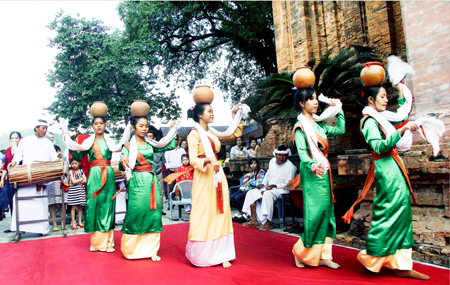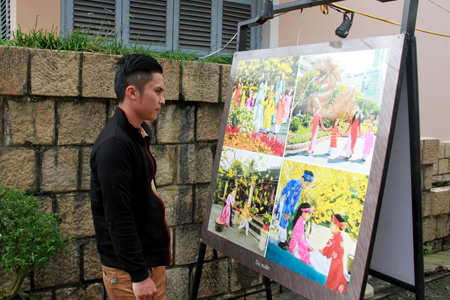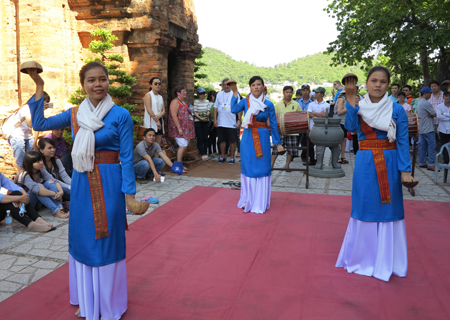
Visiting Ponagar Temple on the occasions of festivals or Lunar New Year, people in Nha Trang and tourists can see Cham women dressing traditional costume of Cham people, dancing along to lively drum-beats.
Visiting Ponagar Temple on the occasions of festivals or Lunar New Year, people in Nha Trang and tourists can see Cham women dressing traditional costume of Cham people, dancing along to lively drum-beats.
 |
| Dancing with terracotta jars. |
Cham dance is the typical cultural heritage of the Cham with the dances derives from daily activities and work of the locals or the movements of animals. Besides, the dance movements of Cham people are also influenced by the legends of deities like Shiva and Po Inư Nagar. Cham people dance in the festivals to address prayers to the deities, wishing for bumper harvests.
Reportedly, Cham dance includes folk dance, royal dance and religious dance. The dances performed in Ponagar Temple are mainly of folk dance, which are the simulation of familiar movements in daily life.
According to Cham dancer Su Ngoc Thanh Thuy, the movements of Cham dance are quite simple and primarily focus on hand and leg movements. Cham people also use some props in their dance, such as terracotta jar, fan, and dipper made of coconut shell. When performing dance with terracotta jar, the dancers dance while holding a terracotta jar on their head. This movement stimulates the image of Cham women taking water from stream or carrying water to temple.
Peacock dance is the typical dance of Cham people. As reported by Van Ngoc Chi, leader of Cham dance group in Ponagar Temple, there is a legend that Thien Y Ana Goddess and the fairies often ride peacocks descending on earth to help villagers to build the land. The Cham were very impressive with extremely beautiful image of the peacocks’ wings when they flying. Therefore, they memorized the movements the peacocks spreading wings and created peacock dance.
Cham dancing is not only a work but also something which is very dear to many Cham dancers because they have been closely connected to the dances since they were little children.
At present, the Cham dance troop at Ponagar Temple includes five dancers and three instrumentalists playing “Ginăng” drum and “Saranai” clarinet. The choreographer is also Cham; therefore, the dances performed by this troop bear a lot of typical cultural characteristics of Cham people. The troop now also performs some dances to modern, lively music.
In the past, Cham dance were performed only on the occasions of festivals and Lunar New Year. In nearly ten years, Ponagar Temple holds Cham dance performance every day to serve tourists. The troop only takes two or three days off per year on Katê festival of Cham people.
“Performing Cham dances on the ancient temple is meaningful in term of arts and spirit. Through many years, this activity has proved its attractiveness to tourists and effectiveness in promoting the local culture and tourism. It has received good response from both tourists and tour operators. Cham dances have also partly helped to increase the attraction of the monument,” said Tran Dinh Dung, Director of Khanh Hoa Provincial Vestige Preservation Center.
Nhu Thao
Translated by H.N










